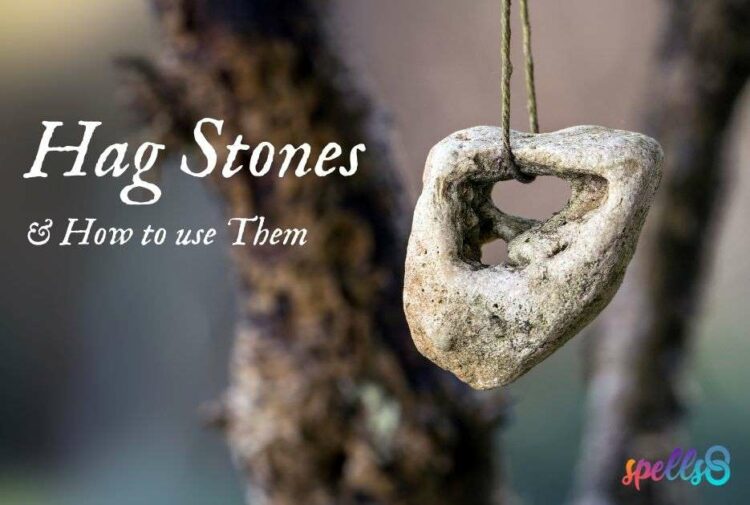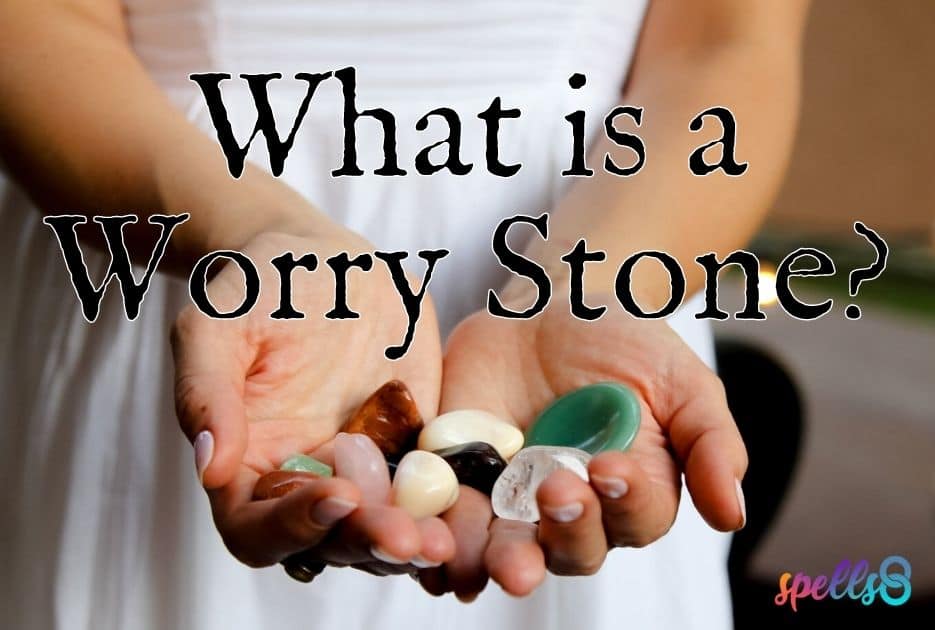Have you ever walked along a river or stream collecting stones, only to find one with a perfect hole through it? If you have then you must be lucky! These hole-bearing stones have other names, too. They are also called witch stones, holey stones, and serpent’s eggs.
They have fascinated humans for hundreds of years, garnering folklore and stories about their magick and mystery. A Hag Stone is a stone with a naturally occurring hole or hollow. They are thought to have magical properties and have been used in various cultures to protect against evil or as talismans of good luck.
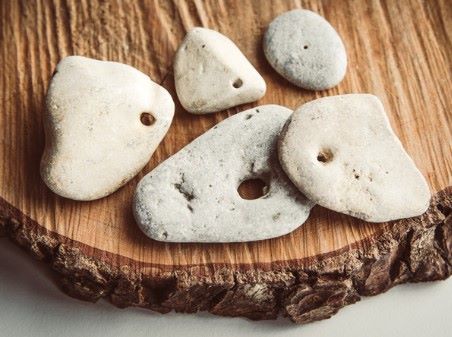
How are Hag Stones made?
There are two ways a hag stone is created. The first method is by a type of clam called a Pholad clam. These clams attach to stones and burrow holes to escape predators. Naturally, this will leave hollows in the stone. If the clam burrows all the way through the stone, there will be a naturally-formed hole.
The other method of hag stone creation is rarer. This involves a stone getting stuck in a certain way that another stone or piece of sand is rubbed against it continually. Over time, this type of erosion can cause a hole to form in the stone. Again, this is the rarer type of hag stone and there is almost no way to tell if a hag stone has been created by a clam or erosion.

There are some sellers out there that drill holes in river stones and sell them as hag stones. This is not common practice at all, just something to be aware of. One way to tell the difference between a true hag stone and a man-made one is to look for sharp edges on the inside of the hole. A large hag stone with only one hole is also suspicious. However, some sellers will grind down stones to make smaller pendants. If you are purchasing a hag stone from someone, ask them about their hag stones. They should be more than willing to answer any questions you have.
Where to find a Hag Stone
Finding a hag stone is going to be easy if you live near a coastal region or moving body of water. Hag stones can be formed in many different types of minerals, but the most common is flint. If you want to know if your beach has hag stones, look for the presence of Pholad clams. You can check with your local wildlife foundations, look it up on Wikipedia, or ask around with other beach-goers and hag stone enthusiasts!
You may have great luck finding a hag stone near a shallow pool of water filled with anemones and small wildlife. These are often called tidepools, and anemones will take up residence in a hole left behind by a Pholad clam. If you are not at the beach, try looking in an area where water pools or flows quickly. Be careful not to get too wet!
Hag Stone folklore
As naturally occurring stones with holes, hag stones are steeped in folklore and folk magic. You will find hag stones in use today in British folk magick as well as other Western folk magick practices. Their use goes back hundreds of years, and the name “hag stone” is a reminder of one original use — to keep away witches!
The Odin Stone
Thought to have been erected over 5,000 years ago, the Odin Stone was a standing stone about eight feet high with a very large hole bored through the middle. Stories were told that couples who were to be married would stand on either side of the stone and reach their right hands through to each other while saying their vows. It was seen as a testament to their vows of faith and love.
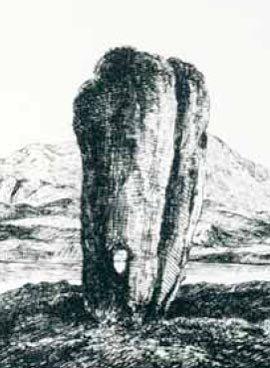
In 1814, a man named Captain W. Mackay set out to destroy The Odin Stone and many other megaliths in Orkney. He claimed that the travel and visits from the people of Orkney to the megaliths were ruining his land. Thus, this large holey stone was destroyed.
Pliny’s Natural History
In book XIX of Pliny’s Natural History, he talks about something called an adder stone that was held in high regard by the Druids. Pliny was an ancient Roman philosopher who recorded countless important pieces of history from his time. Of the adder stone of the Druids, he had this to say.
[T]here is another kind of egg, held in high renown by the people of the Gallic provinces, but totally omitted by the Greek writers. In summer time, numberless snakes become artificially entwined together, and form rings around their bodies with the viscous slime which exudes from their mouths, and with the foam secreted by them: the name given to this substance is “anguinum.” The Druids tell us, that the serpents eject these eggs into the air by their hissing, and that a person must be ready to catch them in a cloak, so as not to let them touch the ground; they say also that he must instantly take to flight on horseback, as the serpents will be sure to pursue him, until some intervening river has placed a barrier between them. The test of its genuineness, they say, is its floating against the current of a stream, even though it be set in gold…I myself, however, have seen one of these eggs: it was round, and about as large as an apple of moderate size; the shell of it was formed of a cartilaginous substance, and it was surrounded with numerous cupules, as it were, resembling those upon the arms of the polypus: it is held in high estimation among the Druids. The possession of it is marvellously vaunted as ensuring success in law-suits, and a favourable reception with princes…
Pliny the Elder – Natural History, Book XIX
By Pliny’s description of the adder stone, we can see that it was held in high regard. It was thought to bring good luck to those that needed it. It was also a stone that people would fight over or envy others for having.
Celtic Mythology
Hag stones have stories in many Celtic countries. For example, in the Mabinogion of Welsh mythology, there are two stories mentioned with stones that may be adder stones. These include Perceval, the Story of the Grail, and Owain, or the Lady of the Fountain. In both stories, magickal stones help the hero overcome whatever challenges they are presented with.
It is also believed that holding a hag stone up and looking through it can help a person see the hidden world of the Fae. This belief may or may not be an ancient legend, but it is a belief that has carried into the modern world.

The Curse of Aleister Crowley
Just about everyone is familiar with the stories of Aleister Crowley, but did you know that he supposedly cursed the town that he died in? It’s said that in 1947, Crowley died in Hastings, England. Before he died, he cursed the town so that if you lived there, you would never be able to leave. If you tried to leave, you would always come back. The only way to leave for good was to take a stone with a hole from the beach — a hag stone!
Hag Stones in Witchcraft
The use of a hag stone for magickal practice and protection isn’t just ancient history. Hag stones have a lot of modern use today, especially in places still steeped in ancient witchcraft. If you find yourself in possession of a hag stone, count your blessings! Here are a few ways you can use a hag stone in your practice.
Create a Talisman
Hag stones have natural holes in them. This makes it very easy to tie string or thread around them to hang them as talismans. They have always been associated with protection, so a simple hag stone talisman tied with red string and hung in your home can be a great way to ward off evil, bad luck, and negativity.
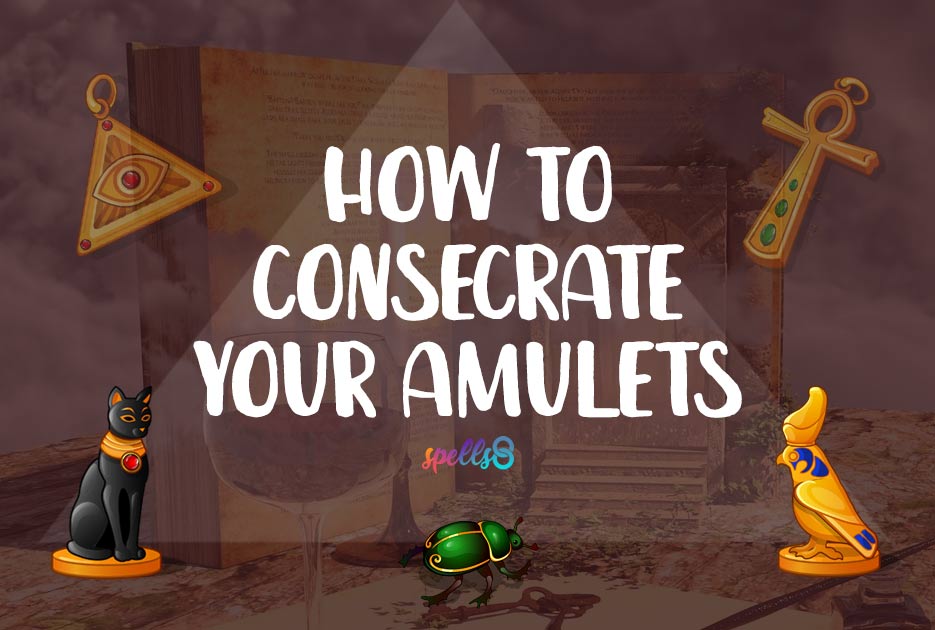
Jewelry
A smaller hag stone necklace can be a simple way to carry protection with you. As Pliny said, hag stones were thought to bring good luck in legal matters but also “favourable reception with princes”. This could mean you may give your communication skills or confidence a boost by partnering with a hag stone.
See also: Simple Jewelry Enchantment 💍
Seer Stone
It almost seems like human nature to peer through small holes in objects — can we see the otherside? How about the Otherside? Use a hag stone to help your visions, trancework, and hedgeriding. It is said that looking through a hag stone can help you see the spiritual world. This includes the realm of the Fae, elementals, and even spirits. Consider including a hag stone in your spirit work rituals!
Let the Search Begin!
Now that you know a bit more about hag stones, it’s time to go out and search for one yourself! Comb the beaches, scour the lakes, and walk through rivers and streams. Dig deep into the water and dirt under the surface. You just might get lucky and find your own hag stone!
Worry Stones and Their Magickal Use
A worry stone, sometimes called a palm stone depending on the size, is a smooth stone with a thumb-sized indentation in the middle. They are often round or oval in shape for easier handling.
9 Crystals for Energy and Motivation
Energy and motivation are two essential ingredients for success in any endeavor. Having the energy to complete tasks and the motivation to push forward will make a significant difference in achieving your goals, whether at work, school, or at home.
Of Seas, Sands, and Tides
The ocean is a vast, ancient, magickal place whose raw power can be felt even by those who have not embraced the Craft. It is a sacred presence across traditions, religions, and spiritualities that honor the natural world and is the very heart of the water element- one of the five elements of magick.

